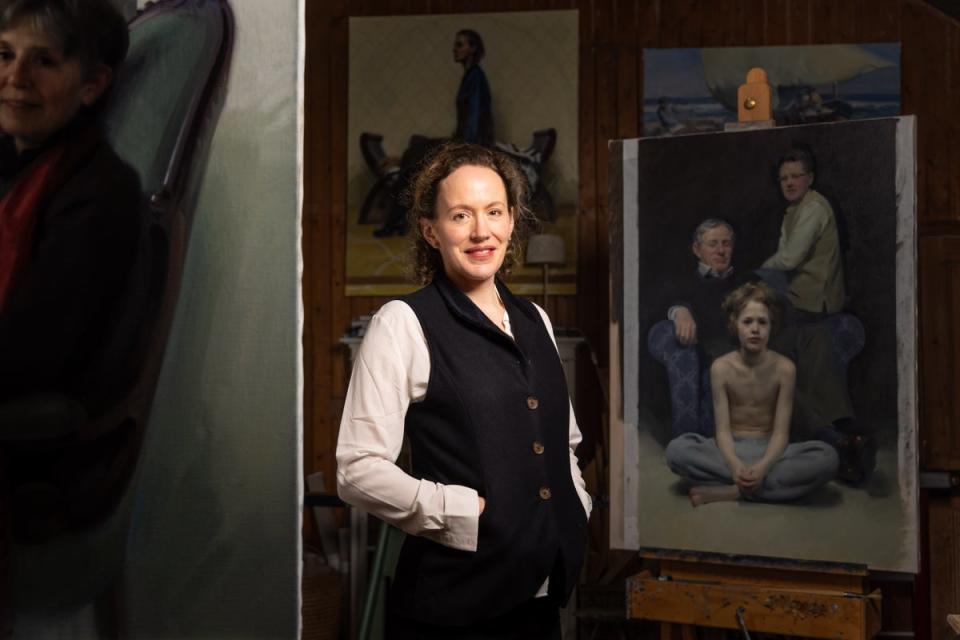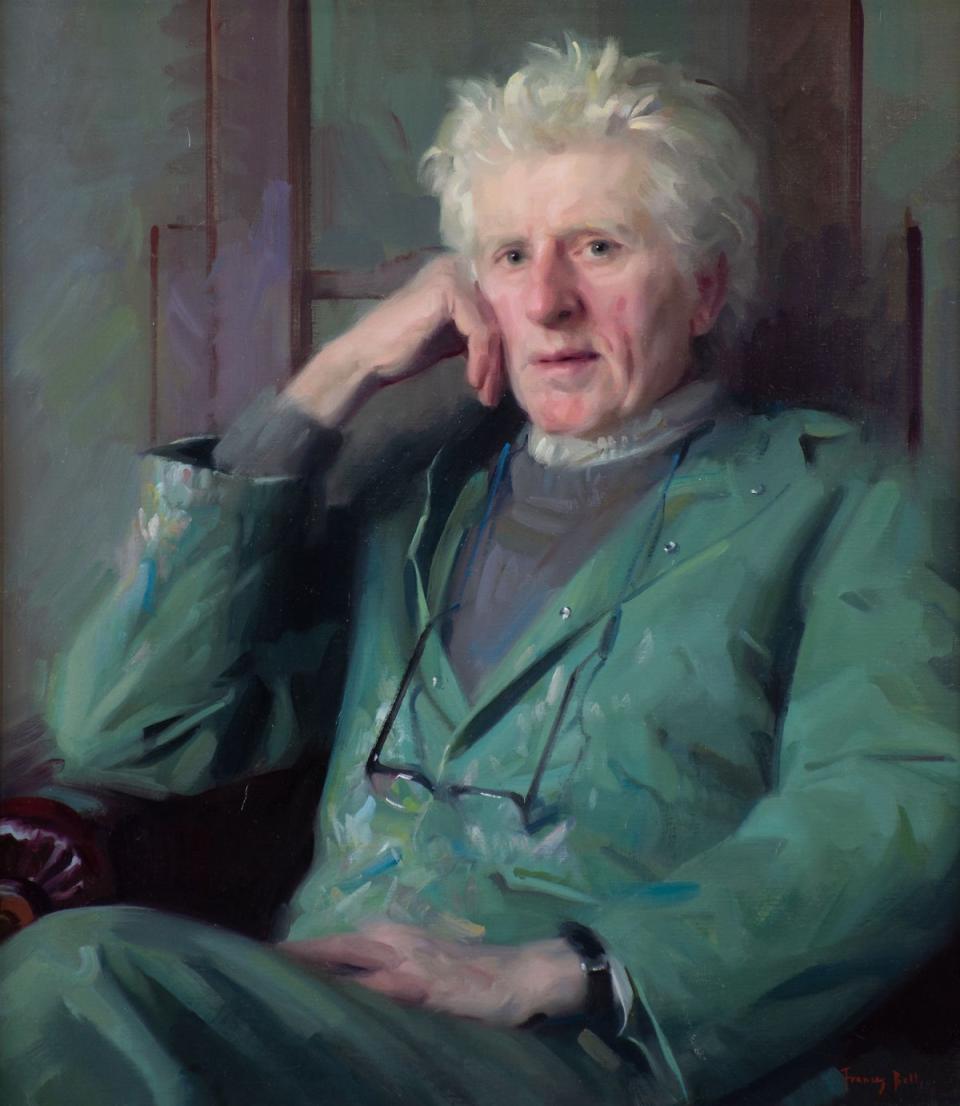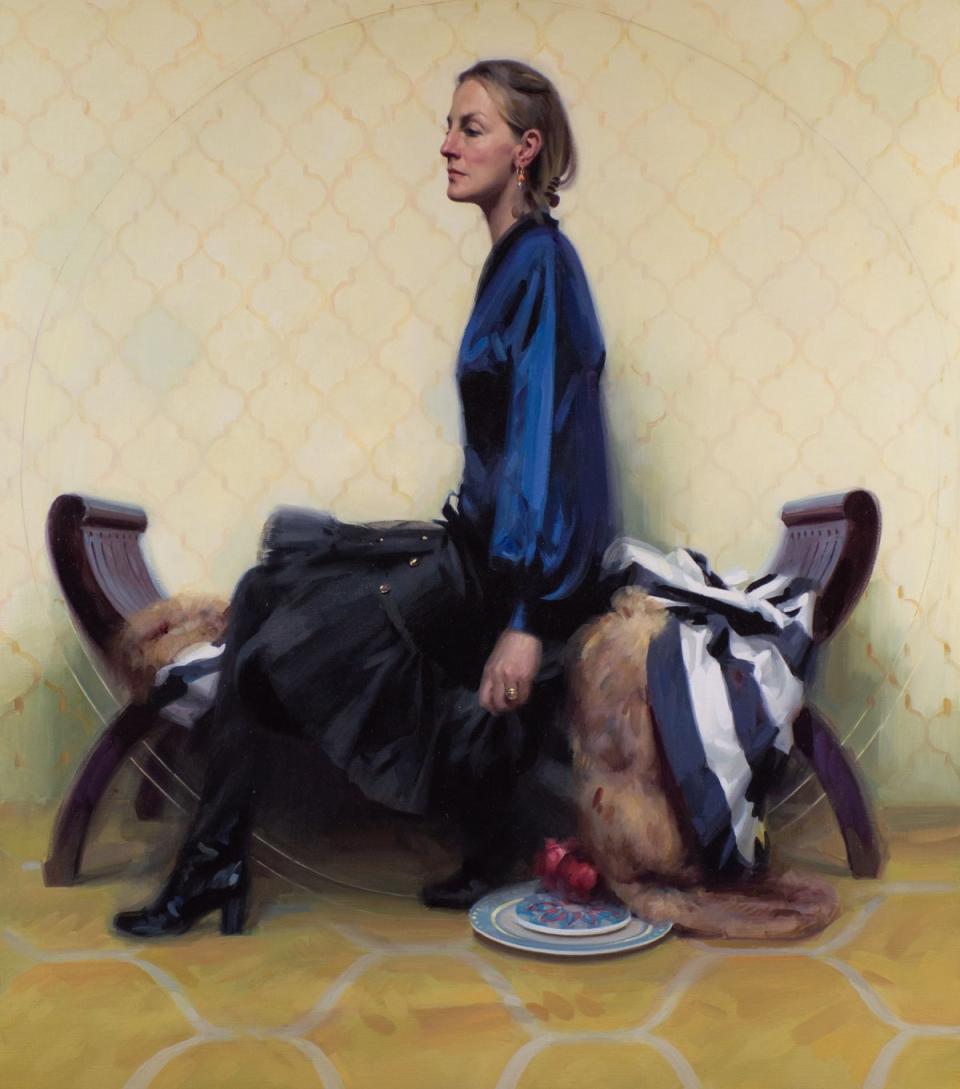When she was 21, painter Frances Bell was living “in a shoe [her] car” scraped by £10,000 a year. “All the starving stereotypes tend to be true,” she says of the early life of an artist.
By then, she had completed a course at the Charles H Cecil Studios in Florence, which was “small”, “very strict” and “nothing like a modern university” – more like “17th century training: all about repetition, intensity”.
“I started very slowly doing disastrous commissions … of friends’ mothers,” she joked. A year later, aged 22, everything changed. She won the De Laszlo foundation award for young artists. Since then, she has become one of the most talented and sought-after portraitists in the country.
Based in Northumberland with her husband – she calls him a “color blind bumpkin” – and two children, aged 11 and 9, she often travels to London for commissions, where we meet on a sunny Wednesday morning.
“I’m not constitutionally built for urban life,” she says, but later admits that London is “the heart of our artistic establishment”. And, it is where the money is.
Among her most distinguished works are portraits of the socialite and self-styled ‘Queen Sloane’, Henry Conway, and former president of the Royal Society of Portraits, Andrew Festing – whose own commissions include portraits of the Queen and the Duke. Kent.
Bell’s portrait of Festing took her to the finals of The International last year: a prestigious competition hosted by The Portrait Society of America.

The prizes, and the patronage behind them, are vital to the future of the arts, says Bell. She has won 21, including the prestigious Valeria Sykes New Light Prize last year and the William Lock Portrait Prize in 2021. “£20,000,” she says of that one. “That was bloody surreal”.
Our conversation comes at a perilous time for the art market, crippled by funding cuts and the impact of the cost of living crisis. Galleries are closing and artists are still underpaid. “I meet artists all the time who have faced an unusual upward battle – one of which is almost always that they leave university with debt,” says Bell. “Without prizes, I don’t know how you’d do it.”
The cliché of the struggling artist is there for a reason and it’s even more challenging after becoming a mother, says Bell. “You want to keep the thread of your work going. It’s harder to pick up wholesale if you quit for five years and start over. I kept painting [while raising children]which made it harder in the short term but easier in the long run.”
Bell’s own mother, an art school graduate, inspired her love of painting during a idyllic, pastoral childhood in Suffolk, which she describes as “Wordsworthian”, “unsexy”, and “generous in a nice way”. .
Bell, a self-described “horse” child, found her mother’s eye drawn to drawing animals. She was sent to school in Yorkshire, where she was blessed with a wonderful art teacher, with the elegant name of Mr. Baby, who nurtured the “tempestuous” young artist. “I wasn’t a fetal achiever at all,” she says. “I would get frustrated and throw the pencils.”
In fact, she failed A-Levels in art. “I got a B,” sighed Bell, quoting from his examiner’s report: “We don’t reward As for these traditional types anymore.”
It was the late nineties and the Young British Artists were in full swing. One of Bell’s school trips was to Sensation, the landmark 1997 exhibition of contemporary art by Charles Saatchi.


The famous show came from works including the perverted child mannequins made by the Chapman brothers where anuses were substituted for mouths and noses for penises. These were alongside Marcus Harvey’s recreation of Myra Hindley’s policewoman from children’s handprints, Damien Hirst’s shark in formaldehyde and Marc Quinn’s sculptural self-portraits made from his frozen blood; and of course, My Bed, perhaps Tracey Emin’s most iconic work.
“I wanted to be a traditional artist,” says Bell. “That was my passion.” Art schools should not obey professors and the whims of the market, or what was fashionable at the time, she continues. Even when it comes to more conceptual art, “drawing will always be useful”.
Schools in Britain used to teach drawing as part of the primary school curriculum: abandoning this, according to Bell, was a “huge loss”. “It’s such an innate thread in our fabric to pick up a pencil and draw.”
“You’re building this odd three-dimensional thing,” Bell says of portraiture. She loves that Instagram has democratized our art consumption, but says there’s no substitute for seeing pictures in person.
For portraits in particular, the interaction between the painter and the sitter informs the brushstroke as much as it informs the light. You’re, Bell says, “distilling and trying to put what they’re saying onto the canvas.”
John E Walker, who won the Nobel Prize in Chemistry the same year Bell saw the Sensations show, was one such man whose conversation was central to his performance.
She wasn’t going to pursue her thoughts on enzymes and adenosine triphosphate (“he did, bless him, try to explain it to me”) – but she wanted to capture “his face while he was talking” and put it on find out what she could relate to. : his passion.
In Bell’s words, the artist becomes “an amateur anatomist, an amateur psychologist and an anthropologist” whose task it is to transfer the atmosphere around their sitters onto the canvas.


She recently painted a few half-nude. “It was very organic,” Bell says, and he hated to show the intimacy of marriage without sexualizing it. “No feather boa,” she says, mimicking a model who is thoughtfully propped across the sofa.
For centuries, women in paintings were either “saints or sluts”: Da Vinci’s portrait of the Mona Lisa was the first to change the game, and for that it “deserves to be the most famous painting in the world ,” says Bell. .
Although her own painting presents a gentle and naturalistic view of the female form, she is not “friendly” to the male gaze (although there was a “trend in which every old woman I saw had a hot water bottle on her lap. . .and that really pissed me off”).
Although “the pressures of idealism and politeness” have persisted for centuries in representations of the female body, some artists – such as Rembrandt or Sargent – have produced significant examples of female portraiture.
That said, Bell is a big fan of women painting women (“there’s a hashtag for you,” she says). The “erotic thing” tends to disappear, in favor of the “much more interesting psychological elements” that emerge.
Our conversation turns to the art establishment and the monopoly of the London market. Bell would like to see schools and art galleries spread across the country “in a nice, democratic way”.
Funding is the main issue, but Bell takes a pragmatic view. “It always confuses me a bit: how do you get government funds for individual artists?” She puts forward a potentially controversial idea: financial incentives to encourage skilled collectors to support the arts more. Which, loosely translated, could easily mean: tax breaks for the super-rich in exchange for their artistic patronage.
It’s funny, I notice, how a conversation about art always turns into a conversation about money. Bell agrees and aims for a system that pauperises young artists. “Institutions need to stop saying, ‘oh, that would be great [your CV] if you worked for us… for free,” she says. “You need to have the payment loop, the patronage, complete.”
The question of who that patron is creates further controversy: arguably the most prestigious portrait painting competition in the world for many years has been the BP Portrait Awards, sponsored by the oil and gas company until 2022.
So, is there a world where people can visit galleries for free, artists don’t struggle, and the entire ecosystem is funded by businesses or private individuals with bottomless wallets and track records squeaky-clean? The answer, of course, is no.


The biggest companies in the world today – all possible future sponsors – are in technology, an area I want to ask Bell about. “There are big issues of copyright and ownership,” she says of AI-made art, comparing such generators to meat grinders that gobble up and recreate content created by real-life artists like her. “There should be a moratorium on accepting artwork [created by a robot] enter art competitions.”
For Bell, art created by the human hand will always be better, and that is the story of how it was produced; human interaction between painter and decorator. It is an intangible that no algorithm can replicate; and which brings ineffable life to a picture.
“Art is a physical, tactile trade,” says Bell. Pictures have a “pulse” that we can only fully appreciate when we see them hanging in galleries. “You want a work of art that washes over you, even though you have no idea how it was made,” she concludes. “It’s a portal into a world. I don’t mean to be a cynic, but no screen can do that.”
Frances Bell’s work will be shown as part of the Royal Society of Portrait Painters’ annual exhibition, May 9 to 18; therp.co.uk